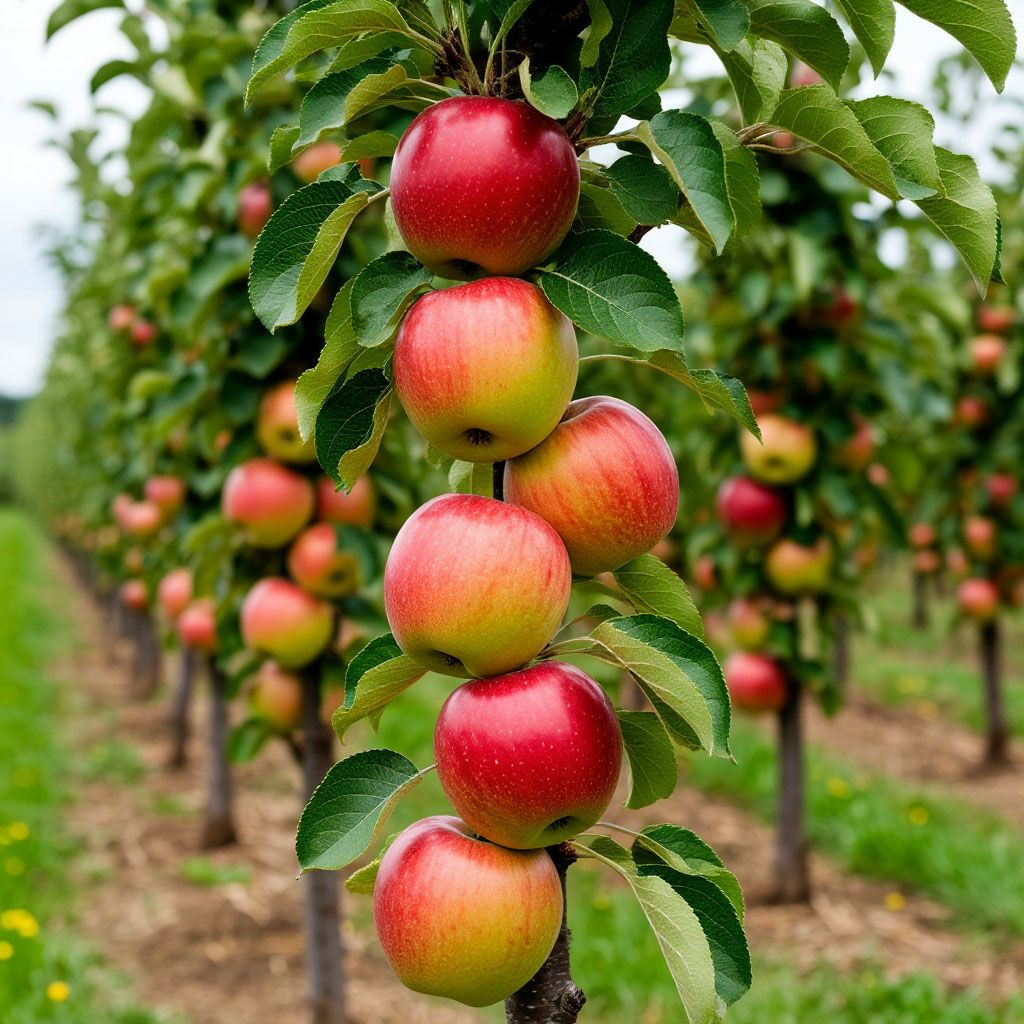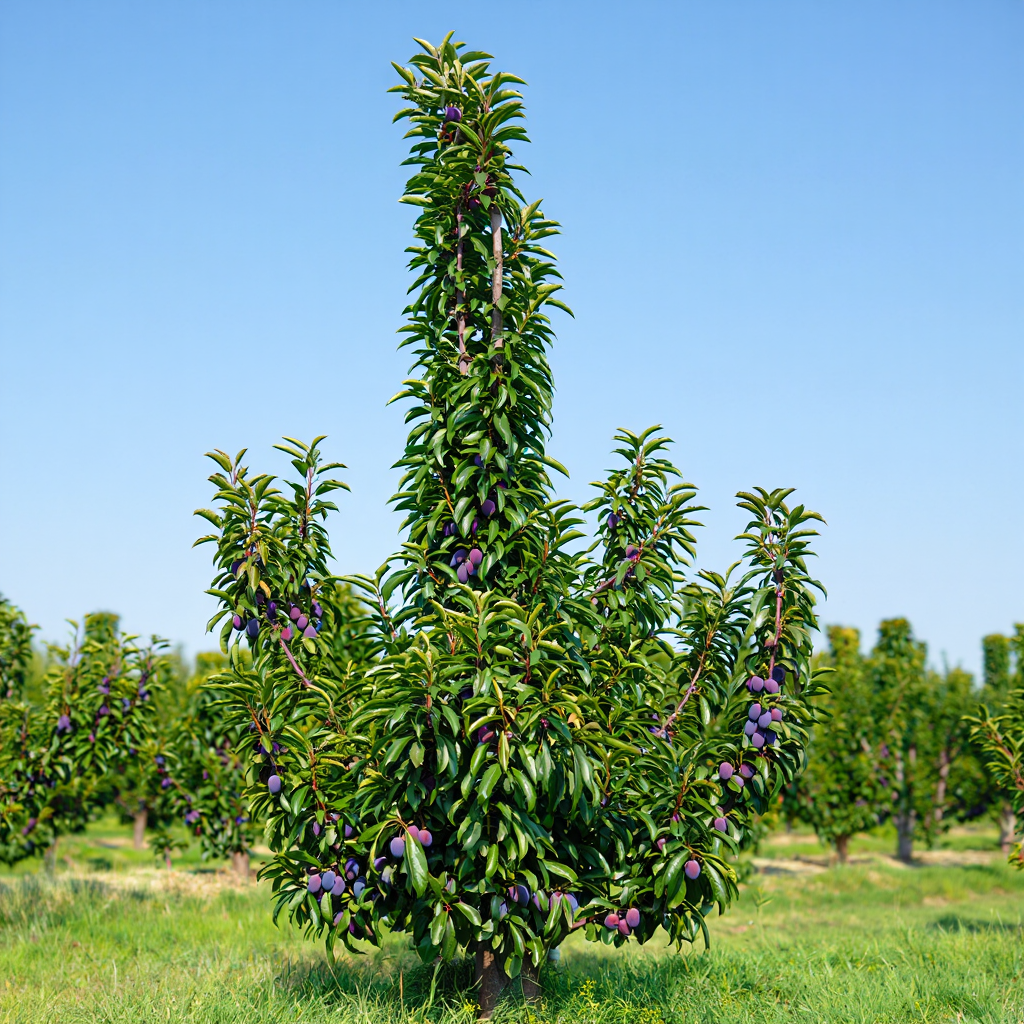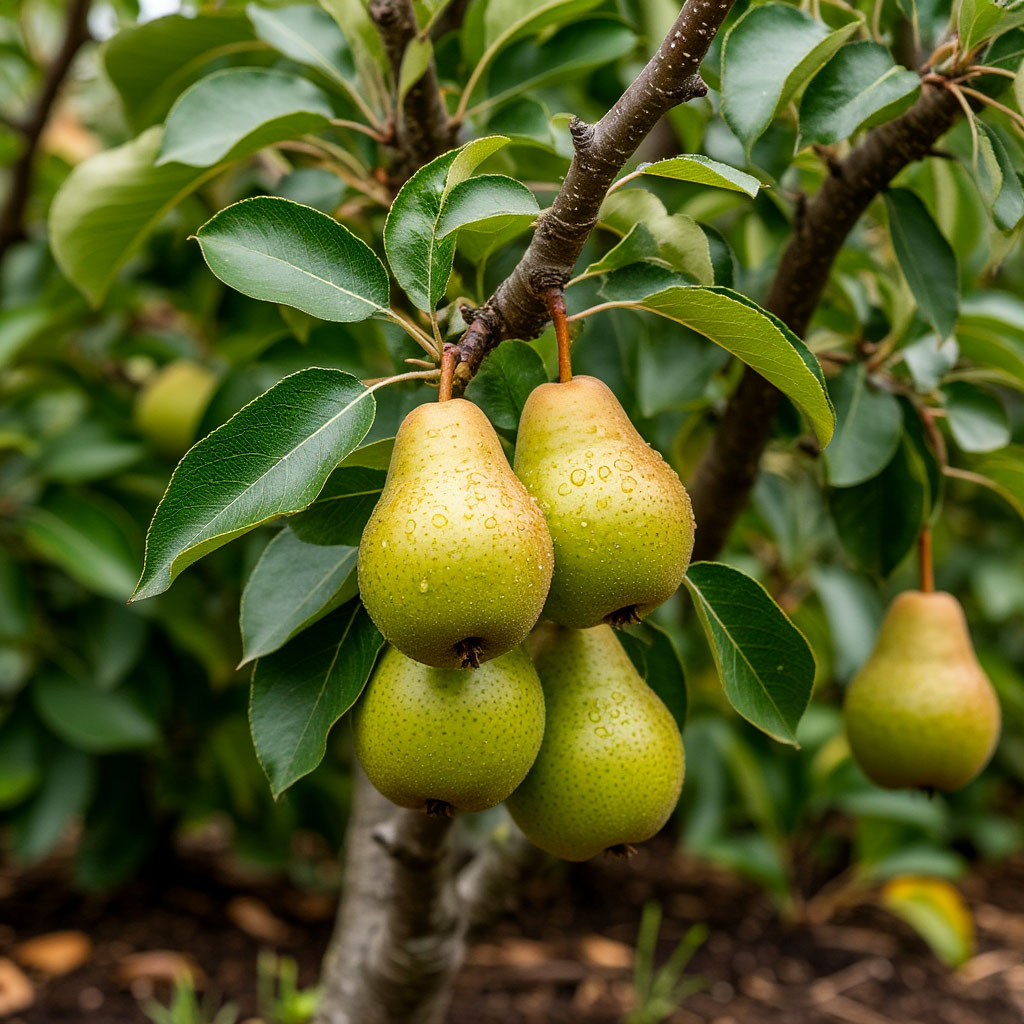Columnar apple trees are an ideal solution for owners of small plots who want to get a bountiful harvest without having to plant large trees. These compact plants take up a minimum of space, while they delight with juicy fruits within a couple of years after planting. In this article, we will look at how to plant columnar trees, take care of them, and which varieties are best suited for a small garden.
At the end you can download a brochure in which you’ll find a decision checklist, compact planting and container specs, training and pruning for a slender column with spur management, watering and feeding basics, a seasonal calendar, and a small planning worksheet.
Columnar apple trees: varieties
Columnar apple trees are represented by a variety of varieties that differ in terms of ripening, fruit taste and resistance to diseases. There are several popular options.

President
The columnar apple tree of the President variety is a compact tree with a vertical growth form. The main characteristics of the variety include a minimum number of side branches. Adult tree height: usually reaches a height of 2 to 3 meters. It has a high yield on young trees. The apples themselves are medium-sized, rounded, greenish-yellow in color with a blush and a pleasant sweet and sour taste
This is a late autumn variety, the fruit ripens in September-October. Fruits are well stored until January-February.
Nectar
The name of this variety speaks for itself – its fruits have a pronounced honey taste. Apples of medium size (100-150 g), rounded, yellow in color with a delicate skin. The flesh is grainy, very sweet, almost without sourness. “Medok” ripens in late summer, and the yield reaches 8-10 kg per tree. This variety is frost-resistant (withstands up to -40°C) and is suitable even for regions with harsh winters.
Ostankino
One of the most productive varieties of columnar apple trees. The tree grows up to 2-2. 5 meters, the fruits are large (up to 250 g), bright red, with a dense skin. The taste is rich, sweet and sour, with a slight aroma. Ripening begins in mid-September, and with proper storage, apples can lie until December. “Ostankino” is resistant to fungal diseases, which simplifies its care.
Vasyugan
Ideal for the northern regions, as it can withstand frosts up to -42°C. The tree is medium-sized (up to 3 m), the fruits are small (100-140 g), but very beautiful-bright red, with dense pulp. The taste is sweet and sour, with a slight astringency. Vasyugan ripens in September, the yield is 6-8 kg per tree. It is highly resistant to diseases and pests.
Arbat Street
This variety belongs to the semi-dwarf, the height of the tree rarely exceeds 1.5-2 meters. The fruit is small (60-80 g), but very sweet, with a cherry-red skin. The flesh is juicy, with a slight honey taste. Ripens in August, but it is not stored for long – it is better to use it fresh or process it. Arbat is very decorative and is often used in landscape design.
Gin
Early-maturing variety, the fruits of which ripen in late July-early August. Apples are bright red, medium-sized (120-150 g), with a dense pulp and a pleasant sweet and sour taste. Yield – up to 5-7 kg per tree. “Gin” is resistant to scab, tolerates frosts up to -35°C.
Chervonets
Large-fruited variety with apples weighing up to 200-250 g. The fruits are dark red, with a dense skin, very juicy, with a rich sweet taste. Ripens in September, yields up to 10 kg. “Chervonets” is well stored (up to 2 months), resistant to diseases and suitable for commercial cultivation.
Best columnar varieties
If you are looking for the most productive and delicious options, pay attention to the following varieties:
- Arbat is a compact tree with small but very sweet fruits.
- Gin is an early-ripening variety with bright red apples.
- Chervonets are large fruits with a rich taste.
These columnar apple trees are great for small orchards and produce a stable crop.
How to plant columnar trees

Planting columnar apple trees has its own characteristics, which are taken into account for the successful cultivation of these compact trees. Unlike traditional apple trees, columnar varieties require more dense planting and special attention to soil preparation.
Pick-up time selection
The optimal time for planting is early spring (before budding) or autumn (September-October), 3-4 weeks before the onset of frost. Spring planting is preferable in the northern regions, as it gives the tree more time to root before winter. Autumn planting is well suited for the middle zone and southern regions.
Place preparation
Columnar apple trees like sunny, wind-protected areas with deep groundwater (no closer than 2 meters to the surface). The ideal soil is light loam or sandy loam with neutral acidity (pH 6-6. 5). For 2-3 weeks before planting, dig up the area, removing weeds and roots of perennials.
Preparing the landing pit
Dig a 50×50×50 cm hole. At the bottom, lay drainage (expanded clay, broken bricks) in a layer of 10-15 cm, this is especially important for heavy clay soils. Mix the extracted earth with:
- 3-4 kg of humus or compost;
- 80-100 g superphosphate;
- 60-80 g of potash fertilizer;
- 200-300 g of wood ash.
The landing process
- Place the seedling in the pit, carefully spreading the roots. The root neck should be 5-7 cm above ground level.
- Cover with the prepared soil mixture, slightly compacting it.
- Form a watering circle and pour copiously (20-30 liters of water).
- After water is absorbed, cover the trunk circle with peat, humus or sawdust in a layer of 5-7 cm.
- Set up a support peg and tie up the tree.
Landing scheme
Thanks to its compact size, columnar apple trees can be planted denser than ordinary ones:
- Between the trees in a row – 40-60 cm.
- Between the rows – 1-1. 5 m.
With this scheme, up to 50-60 trees can be placed on 1 acre.
Features of planting seedlings
Choose annual seedlings – they take root better. Pay attention to:
- condition of the root system (must be developed, without damage);
- no signs of disease;
- the presence of a live apical kidney (its damage will disrupt the columnar shape);
Immediately after planting, it is recommended to trim the seedling, leaving about 80 cm in height, to stimulate the development of lateral fruit branches.
Post-planting care for columnar apple trees
In the first month, regular watering is especially important (2-3 times a week). In the first year, remove all the flowers to make the tree stronger. For the winter, young plantings should be insulated: wrap the trunk with burlap, and cover the trunk circle with a thick layer (10-15 cm) of organic matter.
Proper planting is the key to successful growth and fruiting of columnar apple trees. If you follow these recommendations for 2-3 years, you can get the first harvest of delicious apples from miniature trees.
Caring for columnar apple trees

Columnar apple trees require special care, different from that of traditional fruit trees. Their compact shape and surface root system dictate specific rules of agricultural technology. Consider all aspects of seasonal care.
Watering system
Due to the underdeveloped root system, columnar apple trees are particularly sensitive to soil moisture:
- In spring, watering is carried out every 7-10 days (10-15 liters per tree).
- In summer, in the heat – 2-3 times a week (20 liters).
- Since August, watering is gradually reduced.
- In autumn (October), water-charging irrigation is carried out (50-60 liters).
Top dressing options
Fertilizer application schedule:
- Early spring: ammonium nitrate (50 g / wood) or urea.
- May: infusion of mullein (1:10)or chicken manure (1:20).
- June: complex mineral fertilizer (nitroammofoska).
- August-September: phosphorus-potash fertilizers (superphosphate + potassium sulfate).
Pruning and shaping
Features of cropping:
- Do not cut off the central conductor (except in cases of freezing).
- Lateral branches are shortened to 2-3 buds.
- Sanitary pruning is carried out in early spring.
- In summer, you can pinch strong-growing shoots.
Protection from diseases and pests
To prevent the development of diseases, treatment is carried out:
- Early spring: 3% Bordeaux liquid (for fungal diseases).
- On the green cone: insecticides (Actara, Decis).
- After flowering: Skor or Horus + Fitoverm.
- In autumn: treatment with copper sulfate.
Wintering grounds
Preparing for the cold weather involves performing several mandatory actions:
- Whitewash the trunks (from sunburn).
- Tying trunks with lapnik (from rodents).
- Mulching of the trunk circle (10-15 cm).
- In the northern regions – shelter with agrofibre
Features of fruiting
For a stable harvest:
- In the first year, remove all the flowers
- In the second year, leave 5-6 ovaries
- In subsequent years, the crop is normalized (no more than 15-20 apples per tree)
- Under heavy fruit branches put props
Rejuvenation of columnar apple trees
After 10-12 years, productivity decreases. Can:
- perform a strong anti-aging pruning;
- remove old ringworms;
- strengthen top dressing.
Tip: Columnar apple trees are particularly responsive to foliar top dressing. During the growing season, it is useful to spray the crown with a solution of humates or complex fertilizers with trace elements.
Dwarf fruit trees
Dwarf fruit trees are becoming increasingly popular among gardeners due to their compact size and early fruiting. Unlike traditional tall varieties, these miniature plants have a number of unique characteristics that make them an ideal choice for small plots.
The main advantages of dwarf trees:
- Compact size (height 1.5-2.5 m against 4-6 m for ordinary trees).
- Early start of fruiting (2-3 years after planting).
- High yield per unit area.
- Simplified care and harvesting.
- Possibility of a tighter fit.
- Better wind protection due to its low height.
Columnar apple trees are a great choice for those who want to grow fruit in a limited space. Proper planting, timely care and well-chosen varieties will provide you with delicious apples for many years to come. If you are looking for compact and high-yielding trees, dwarf apple trees are the perfect solution for your garden.
Keep it handy — download the brochure: CD Columnar Apple Trees — Mini Brochure (PDF).


